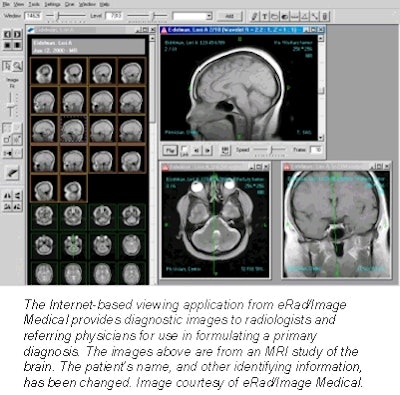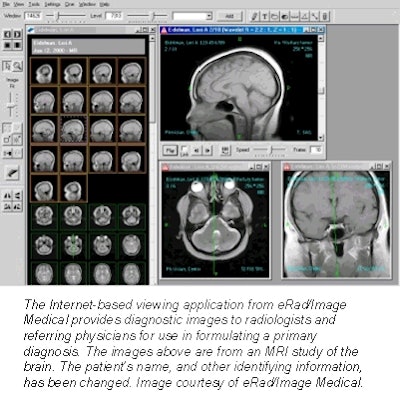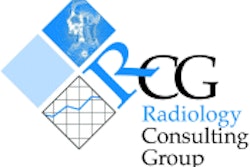
It's not easy to find a PACS vendor these days that doesn't make the Web a key component of its offerings. And Allentown, PA-based eRad/Image Medical is no exception, offering Web-based enterprise-wide image management as well as overreading services.
eRad/Image Medical was formed last month following the merger of Allentown, PA-based eRad Services and Web-based image management firm Image Medical of Palo Alto, CA. The two firms were already familiar with each other, as eRad had been licensing Image Medical's Practice Builder software since 1999. The eRad group will now serve as the company's sales arm, with Image Medical retaining technology development responsibilities.
In contrast to other PACS vendors, eRad/Image Medical can also provide radiology reading services in addition to PACS software and off-site storage, said Peter Karoly, chairman and CEO. The vendor has contracted with Germantown Imaging in Philadelphia to provide overread services, and also has relationships with several other imaging centers and radiologists around the country.
"There's a big need for radiologists right now, especially neuroradiologists," Karoly said. We tell [prospective customers] we're here not to take your business, but to augment your business, to bring virtual locum tenens there. The outside world would not know [the overread services] would exist, but the work would get done by highly qualified radiologists."
As for its technology, eRad/Image Medical's Practice Builder software could serve as a Web-based image distribution component for an existing PACS, or serve as a PACS on its own, Karoly said. The company can provide long-term image storage via an application service provider (ASP) model, or on-site, if the customer prefers, he said.
ASP images are stored off-site at data centers in several geographic locations, which the company declined to name for security reasons. Secure socket layer (SSL) protocols are used for encryption, allowing users to avoid the expense of setting up virtual private networks (VPNs), according to the firm.
For customers choosing on-site storage, eRad/Image Medical will deploy a combination of digital linear tape (DLT) for long-term storage and redundant arrays of inexpensive disks (RAID) for short-term archiving, said Bobby Roe, director of technology.
The ability to work effectively with "small-pipe" architecture is an important factor separating eRad from other companies, according to the firm.
"Using FDA-cleared, bit-level lossless wavelet compression, the software can provide smaller amounts of data, but can provide exactly the same image for the clinician to use in their reading process," Roe said.
 |
To speed delivery, the software also employs client-configured prefetching, which allows customers to use dynamic IP addresses (typically used by computers during dial-up, cable, and digital subscriber line (DSL Internet connections), and still take advantage of advance delivery of full-fidelity images, Roe said.
"As long as there has been sufficient time for the data to be delivered over whatever the bandwidth is, the appearance is that it's instantaneous delivery," Roe said. "Let's say you have an orthopedic specialty office, and they are referring three or four cases a day to the local MRI center. Each one of those cases takes, in raw bandwidth time over a dial-up connection, 30 to 45 minutes to transmit. But realistically, how often is the orthopedic office going to look at those images within 45 minutes of when the study is completed? Almost never."
The thin-client workstation regularly checks in with the eRad server to see if any images are available for retrieval. An ActiveX control ensures that the viewing application is continuously updated, if the user chooses to do so. Once images become available, the workstation retrieves only the studies that are appropriate for the physician, he said.
"For example, if you're a radiologist, you only need to retrieve those studies that have not been viewed," he said. "If you're a referring physician, you only need to retrieve them once the report has been marked preliminary or final, depending on the workflow [of the institution]."
Access to the PACS for both radiologists and referring physicians begins with the vendor's configurable and proprietary worklist, Roe said. The company elected to use a non-DICOM-compliant worklist because of DICOM worklist's requirement that imaging modalities support DICOM query/retrieve.
"Almost no modalities that use secondary capture devices, which is about 90% of the market, have DICOM query/retrieve support on their secondary capture DICOM conversion equipment," he said. "And certainly less than half of those 10% that are already (native) DICOM have support for query/retrieve as well."
In terms of image viewing capabilities, real-time window and leveling is available, as are automated hanging protocols. Images can be viewed on multiple "panes," and a localizer function allows physicians to identify exactly where the image slice was taken, he said. A new feature, called Magic-X, allows a radiologist to mark a location on an image slice, which is then automatically marked on the remaining studies in that series.
In addition to technology, the company will also provide marketing services such as seminars, to help attract referring physicians by showing them how the software is beneficial, said Edward Eidelman, vice president and general counsel.
Today, eRad Image Medical has 55 clients. One key customer, the Medical University of South Carolina (MUSC) in Charleston, is using eRad/Image Medical's software for its outreach program to other imaging centers and smaller hospitals, Karoly said.
MUSC will also take advantage of neuroradiology reading services from eRad, and integrate eRad's software with the facility's existing PACS network, Karoly said. MUSC chairman of radiology Dr. Thomas Pope serves as chairman of the vendor's medical advisory board.
By Erik L. RidleyAuntMinnie.com staff writer
August 15, 2001
Copyright © 2001 AuntMinnie.com




















